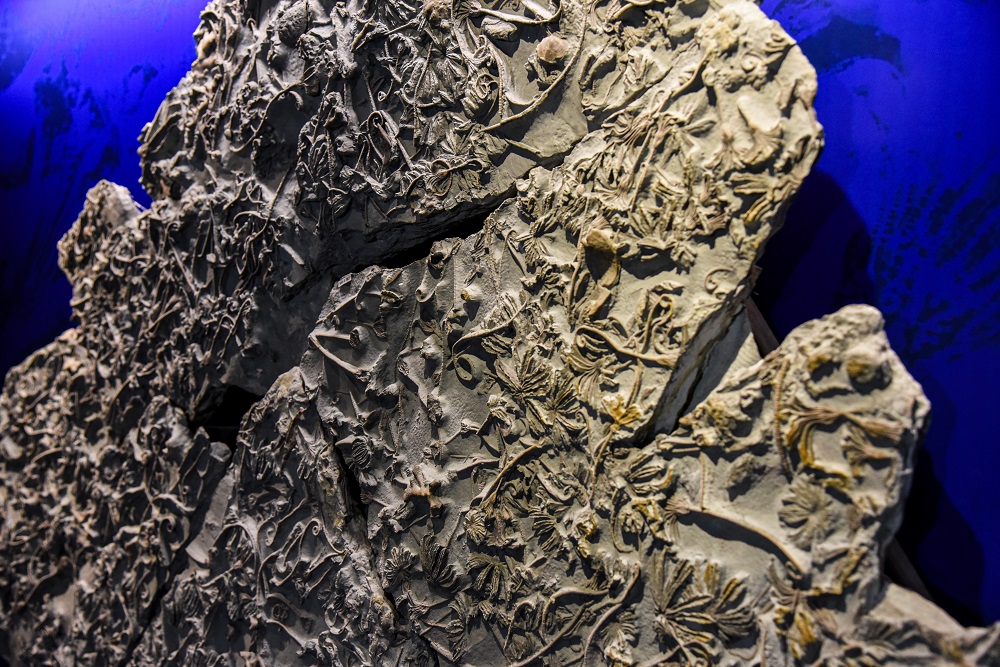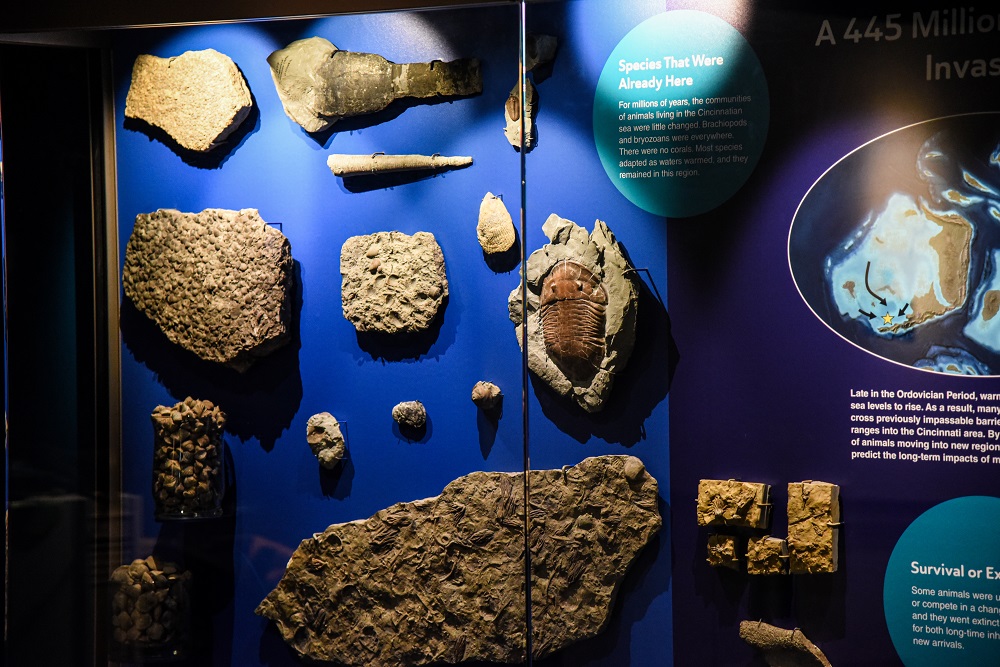
Press Room
FOR IMMEDIATE RELEASE: September 5, 2023
New exhibit featuring 450-million-year-old fossil collection opens this month
Ancient Worlds Hiding in Plain Sight opens Sept. 29 at Cincinnati Museum Center
CINCINNATI - Without knowing it, many Tristate residents have peered 450 million years into the past. Whether it’s been splashing through a local creek bed, exploring parks or sitting bumper-to-bumper at the Cut-in-the-Hill, you’ve seen for yourself traces of our prehistoric past. A new permanent exhibit at Cincinnati Museum Center (CMC) is transporting you back in time to learn more.
And, though the exhibit has been 450 million years in the making, you won’t have to wait that long to visit. CMC’s new Ancient Worlds Hiding in Plain Sight gallery opens this month. You’ll be able to walk the prehistoric sea floor when it opens September 29. 
Ancient Worlds Hiding in Plain Sight presents an immersive journey through the Paleozoic Era, beginning with the Ordovician Period – well before the dinosaurs in CMC’s Dinosaur Hall thundered across the land – where trilobites, arthropods, early echinoderms and giant cephalopods thrived in the warm tropical sea that covered the Greater Cincinnati area so long ago. To do so, the gallery showcases CMC’s world-class Ordovician fossil collection, regarded as one of the finest and largest in the world. And for good reason. Cincinnati is a hotspot for Late Ordovician fossils.
“Exploring ancient animal and fossil communities is accessible to everyone here in the Cincinnati region. They are hiding in plain sight!” said Brenda Hunda, Ph.D., curator of invertebrate paleontology at Cincinnati Museum Center. “That’s what makes our rocks and fossils so amazing – you can grab a bag and a rock hammer, travel to a local creek or outcrop and transport yourself back in time. It’s the closest thing we have to time travel.”
Among the familiar – or strange – faces in the upcoming gallery will be Ohio’s state fossil, Isotelus maximus, a surprisingly large plated invertebrate that resembles a stretched-out horseshoe crab or an aquatic armadillo. Conical mollusks skin to cone-headed squid and handfuls of brachiopods also mingle in the tropical sea. As the gallery marches through time from the Late Ordovician to the subsequent Silurian and Devonian periods, you’ll be introduced to new creatures as marine life evolves, culminating with the fearsome, massive-jawed armored fish Dunkleosteus. As you exit the gallery, you do so through the Carboniferous Period, with plants and animals firmly colonizing land.
Fun fact: Trilobites were the first organisms with complex eyes.
Fun fact: Though the 30-foot Dunkleosteus was toothless, its bony jaw had a bite force equivalent to that of a T. Rex or Megalodon.

The gallery uses soundscapes to immerse you deeper and deeper into the depths of the prehistoric sea and ten-foot-wide monitors turn a portion of the gallery into an ancient aquarium where animated trilobites crawl along the sea floor, fish and giant cephalopods swim overhead and Dunkleosteus chases prey. A gigapixel image of the Edrioasteroid hardground slab allows you to explore the fossilized sea floor through a touchscreen as you uncover fossil facts and reveal what some of the organisms looked like and how they interacted with each other. Surrounding cases display the actual fossil slab. Bronze models give you an opportunity to feel the prehistoric animals and a touchable rock full of ancient remains let you actually touch fossils for real! Explore more using a magnifying glass and sketch your notes in the accompanying field guide. Profiles and stories introduce professional and hobby paleontologists who are contributing to research and our understanding of these long-gone eras.
Ancient Worlds Hiding in Plain Sight is not just an opportunity for CMC to show off its impressive fossil collection. In highlighting this incredible piece of local deep time history, the gallery also addresses themes of climate change, evolution, extinction and species diversification. By continuing to study fossils and how they responded to similar changes over a long period of time, we may be able to better understand today’s major issues.
Fun fact: The Ordovician mass extinction (444 million years ago) and Late Devonian mass extinction (360 million years ago) are among the largest extinction events in Earth’s history. Roughly 86% of Earth’s species were lost in the Ordovician mass extinction and 75% lost in the Late Devonian mass extinction.
Fun fact: The Devonian fish Tiktaalik is considered a critical link in the evolution of marine-based to terrestrial four-limbed animals.
CMC hopes Ancient Worlds Hiding in Plain Sight inspires people to launch their own quest for discovery after their visit. Since Cincinnati is such a hotspot for Late Ordovician fossils, you can begin your own paleontological dig in your backyard, creek or rock wall, with almost guaranteed success. It’s fun to learn about the world around us and the prehistoric world that came before us.
“We hear 450 million years ago and think this time and these creatures are so far removed from us, but we’re ready to show you they’re much closer than you realize,” said Elizabeth Pierce, president & CEO of Cincinnati Museum Center. “Our newest exhibit uses our incredible fossil collection to not just educate you about a bygone era of biodiversity, but to nurture curiosity, illuminate career paths for future scientists and inspire connection between people as they discover their new hobby of fossil hunting.”
Ancient Worlds Hiding in Plain Sight is the latest addition to the award-winning museum as CMC continues an extensive museum experience refresh funded by its $112 million Champion More Curiosity campaign. Since 2018, the campaign has opened 15 new or reimagined exhibits and experiences at CMC, including Made in Cincinnati and the John A. and Judy Ruthven Get Into Nature Gallery in 2022. Additional exhibits and experiences are currently in development with opening dates scheduled through 2024, 2025 and 2026. Those interested in contributing to the Champion More Curiosity campaign can do so at supportcmc.org, as an add-on gift during your online ticket purchase or in person at CMC’s box office.
# # #
About Cincinnati Museum Center
Cincinnati Museum Center (CMC) at Union Terminal is a nationally recognized, award-winning institution housed in a National Historic Landmark. CMC is a vital community resource that sparks curiosity, inspiration, epiphany and dialogue. CMC was awarded the 2009 National Medal for Museum and Library Service from the Institute of Museum and Library Services and received accreditation from the American Alliance of Museums in 2012, one of a select few museums in the nation to receive both honors. Organizations within CMC include the Cincinnati History Museum, Museum of Natural History & Science, The Children’s Museum, Robert D. Lindner Family OMNIMAX® Theater, Cincinnati History Library and Archives and the Geier Collections and Research Center. Housed in historic Union Terminal – a National Historic Landmark restored in 2018 and recognized as the nation’s 45th most important building by the American Institute of Architects – CMC welcomes more than 1.8 million visits annually, making it one of the most visited museums in the country. For more information, visit cincymuseum.org.
Marketing Communications
Cody Hefner
Vice President, Marketing & Communications
(513) 287-7054
chefner@cincymuseum.org
Are you requesting a donation or tickets for your event? Please fill out this form.
Are you interested in renting Union Terminal for a private event? Click here for more information
Museum Admission
Includes Cincinnati History Museum, Museum of Natural History & Science and The Children’s Museum.
| Adult (13+): | |
| Senior (60+): | |
| Child (3-12): | |
| Member Adult: | FREE |
| Member Child: | FREE |
Members receive discounts!
Become a Member today to save on programs, exhibits and films throughout CMC.
Museum Hours
Open Thursday – Monday
10 a.m. to 5 p.m.
Closed Tuesday and Wednesday
Closed Thanksgiving Day and Christmas Day
Member’s-only early entry: Saturdays at 9 a.m.
Customer Service Hours:
Monday – Sunday, 9 a.m. to 5 p.m.

